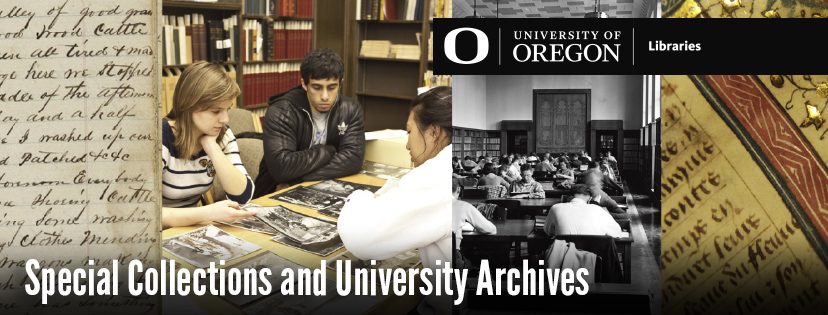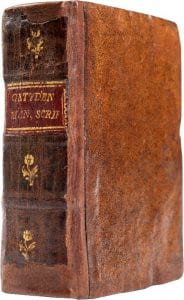New Acquisition Dutch Book of Hours, ca. 1410

In Dutch, illuminated manuscript on parchment Northern Netherlands (Utrecht), c. 1410-1420 Decoration by the Master(s) of Dirc van Delft Group
Special Collections has recently purchased a remarkably early example of a Dutch Book of Hours with extensive, rich decoration related to what has been described as “the beginnings” of Dutch manuscript illumination as represented by a small and coherent group of manuscripts associated with the Counts of Holland and their close circle.
The last time Special Collections obtained a full Medieval Codex was in 1957 when it acquired the Le Geste de Garin de Monglane (MS 065). (see Book Collections in Special Collections and University Archives)
The discovery of any manuscript from the so-called Dirc van Delft Group of manuscripts merits close attention and calls for further study in view of propositions (Delaissé, 1968) that these manuscripts provide evidence of the establishment of the first “workshop.”
PROVENANCE
- The style of the pen-work ornamentation indicates that the book was made in Utrecht around 1410-1420 (see the discussion below). The inclusion in the litanies of three bishops of Utrecht, St. Willibrord, St. Odulph and St. Radboud, and St. Agnes, placed first in the litany of the virgins, confirms the intended use in the diocese of Utrecht. The leaf beginning the litany of confessors, between ff. 64 and 65, is lacking; St. Martin, the patron saint of the diocese of Utrecht, was undoubtedly placed at the head of confessors, as was customary in litanies following the liturgical use of Utrecht.
- Modern booksellers’ notes on the front flyleaf.
TEXT
- 1-43, Hours of the Eternal Wisdom, Hier beghint die getide van der ewiger wijsheyt et cetera,” incipit, “Mine siele heest di begheert…”; [f. 43v, ruled, but blank]; ff. 44-61v, Seven Penitential Psalms, Hier beghint die seven salm, incipit, “Here indijnre verbol ghenheit…”; ff. 61v-78v, Litanies, including St. Willibrord, bishop of Utrecht, St. Odulph, bishop of Utrecht, St. Radboud, bishop of Utrecht, St. Patroclus of Troyes, whose relics are in Soest in Germany, St. Ursula of Cologne, St. Walburga, St. Gertrude the Great, St. Aldegonde of Maubeuge; followed by petitions, invocations, collects and prayers; ff. 79-121v, Office of the Dead, beginning imperfectly (lacking one leaf in the beginning), “//die godliic siin want…”; ff. 122-130v, two Marian prayers, “O soete moeder Gods…” (ff. 122-126v) and “God groet u Maria gloriose heilighe maghet…” (ff. 127-130v); [f. 131r-v, ruled, but blank].
DECORATION
The decoration can most likely be attributed to Utrecht around 1410-1420. The emergence of Dutch manuscript illumination is associated with the removal of the court of the counts of Holland from the Southern Netherlands (Hainaut) to The Hague in the second half of the fourteenth century. By about 1400, a thriving court culture existed under the patronage of Count Albert of Bavaria (d. 1404) and his second wife Margaret of Cleves (d. 1411) and their circle. A coherent group of manuscripts are associated with these “beginnings.” They include three early manuscripts of Dirc van Delf’s Tafel van den Kersten Ghelove, or Handbook of Christian Faith, the first made for Albrect of Bavaria himself (Baltimore, Walters Art Museum, W. 171, fig. 1 and 2), a number of copies of the Saksenspiegel (The Hague, Koninklijke Bibliotheek, MS 75 G 47, fig. 3), a fragmentary Gradual (Darmstadt, Hessische Landes- und Hochschulbiblithek, MS 2296; cf. Hindman; fig. 4), and other manuscripts directly associated with either Count Albrecht or Margaret of Flanders (cf. Marrow, pp. 9-27, and nos. 1-9 on pp. 27-41). Scholars still debate whether these manuscripts were produced in The Hague or in Utrecht, although most textual signs point to Utrecht.
Whereas the present manuscript is devoid of full-page illuminations and may also be lacking its Hours of the Virgin, there is sufficient rich decoration remaining to link it to this early group of extraordinary manuscripts. Two major divisions in the book are marked by large 7-line initials and decorated borders in burnished gold and colors, on f. 1 for the beginning of the manuscript, and on f. 44 for the beginning of the Penitential Psalms. The opening of nearly every hour in the Office of the Eternal Wisdom is marked by a smaller 3-line initial and decorated borders in burnished gold and colors (ff. 2v, 21, 24v, 28, 31, 34, 38v).
Localization of four characteristic motifs, the nucleus, the daisies, as well as the kidneywort and driespits leaves, found in the decorated margins of our manuscript (cf. Proske-van Heerdt, 1992, p. 35), point to an origin in Utrecht. The daisies are drawn with a varying number of petals around a golden core, while the nucleus is a motif with a golden core surrounded by four triangles made up of straight dashes and finishing touches. The leaves attached to the hairline stems, and the larger stems painted in pink and blue with white highlighting, can be divided into two main types, both typical of manuscripts illuminated in Utrecht in the first two decades of the fifteenth century. One of these is the three-lobed kidneywort leaves with rounded edges (leverbloemblaadjes), resembling a clover, of which there is also a version with a concave base. See, for instance, f. 21 in our manuscript for examples of the nucleus, the daisies, and both versions of the kidneywort leaves attached to hairline stems, all painted with burnished gold. The larger kidneywort leaves on f. 1 are painted in colors and gold. The second Utrecht leaf-type found in our manuscript is one resembling a three-pointed hat (driespits) as found, for example, terminating the pink and blue stems on f. 44. A close comparison with the decoration of our manuscript can be found in a Getijdenboek made in Utrecht around 1410, Deventer, Stads- of Athenaeumbibliotheek, MS I 114 (our fig. 4, Deventer, SAB, I 114, f. 252; Proske-van Heerdt, 1992, p. 39, fig. 5). On f. 1, the artist of our manuscript presented the curling kidneywort stems against the wide burnished gold frame to the same effect as the artist of the Deventer book.
The Dutch reformer Geert Grote (1340-1384) translated the Latin Book of Hours into Middle Dutch in 1383-1384. He also added a new important text to the standard contents, the Hours of Eternal Wisdom, the Getijden van de Eeuwige Wijsheid, a translation of the Cursus Aeternae Sapientiae by Henry Suso, found on ff. 1-43 in our manuscript. Although other translations of the Book of Hours exist (in Spanish, French, English), they are exceedingly rare. It was only in Northern Netherlands that the vernacular text became more popular than the original Latin one. This had enormous consequences for the development of lay spirituality, as it transformed everyday prayer from the hieratic, abstract formulae written in the Latin of the clergy to a language that laymen could easily understand, thus providing them more direct and profound access to the divine (cf. Delaissé 1968; König 2012, pp. 10-11).
Eberhard König suggests that once the text was understandable to Dutch readers, they no longer felt the need for the images, and they realized that the conventional narrative cycles in Books of Hours were far removed from the text itself; the getijdenboeken “were made truly to be read” (König 2012, pp. 12-13, 16). Manuscripts without miniatures were also more accessible to audiences with more modest means, but they were, nevertheless, expensive purchases. The discovery of any manuscript from the Dirc van Delft Group of manuscripts merits our close attention because the group is so small, so coherent, and so important to what Delaissé terms the “beginnings” of Dutch manuscript illumination, suggesting as well the establishment of the first “workshop.”
PHYSICAL DESCRIPTION
ii (modern paper) + 131 + i (modern paper) folios on parchment, modern foliation in pencil, 1-131, lacking five leaves (collation i-vi8 vii8 [-3, lacking one leaf after f. 50, with loss of text] viii8 ix8 [-2, lacking one leaf after f. 64, with loss of text] x8 xi8 [-1, -6, lacking one leaf after f. 78 and one leaf after f. 82, with loss of text] xii8 [-5, lacking one leaf after f. 88, with loss of text] xiii-xvii8 ).
No catchwords or signatures, ruled in brown ink (justification 51 x 34 mm.), written in brown ink in gothic book-hand (textualis) in a single column on 14 lines, rubrics in red, capitals touched in red, 1-line initials alternating in burnished gold and blue throughout, decorated with blue and red pen-work, 2-line initials in burnished gold throughout, decorated alternately with red and blue pen-work, seven 3-line initials in burnished gold on grounds divided in pink and blue, accompanied with borders decorated with bars in burnished gold, pink and blue, and branches of leaves and flowers in burnished gold (ff. 2v, 21, 24v, 28, 31, 34, 38v), two 7-line initials, one in blue (f. 1), another in pink (f. 44), decorated with geometric pattern in white, on burnished gold grounds with bar borders in burnished gold enlivened with curling branches of flowers and leaves in burnished gold and colors, a small tear in the outer margin of folio 22 and in the lower margin of folio 93.
Folio 1 darkened and loose from the binding in its lower half, with a small loss to the decoration in the inner margin, ff. 69, 84 loose from the binding, minor stains of water damage in some of the upper margins, small stains and signs of wear, but in overall very good condition.
Bound in the eighteenth century in brown calf, spine gold-tooled with flowers and the title “GETYDEN MANUSCRIP,” endpapers made of multi-colored gold brocade paper with flowers and leaves, modern fitted case, spine restored, stitching of quires somewhat loosened, small marks of wear on the leather, otherwise in in very good condition. Dimensions 100 x 70 mm.
REFERENCES
Delaissé, L.M.J. A Century of Dutch Manuscript Illumination, Berkeley and Los Angeles, 1968.
Gerritsen-Geywitz, G. “Hieronymuspenwerk en andere Utrechtse penwerkstijlen in handschrift en druk,” Spiegel der Letteren 49 (2007), pp. 123-142.
Hindman, Sandra. “Dutch Manuscript Illumination around 1400: Some Cuttings in Darmstadt (Ms. 2296),” Miscellanea Neerlandica: opstellen voor Dr. Jan Deschamps ter gelegenheid van zijn zeventigste verjaardag, eds. E. Cockx-Indestege and F. Hendrickx, Louvain, 1987, I, pp. 419-440.
Korteweg, A. Kriezels, aubergines en takkenbossen, Zutphen, 1992.
Korteweg, A. “Books of Hours from Northern Netherlands Reconsidered: The Use of Utrecht and Windersheim and Geert Grote’s Role as a Translator,” Books of Hours Reconsidered, ed. by S. Hindman and J. Marrow, London, Turnhout, 2013, pp. 235-277.
König, E. Devotion from Dawn to Dusk: The Office of the Virgin in Books of Hours of the Koninklijke Bibliotheek in The Hague, Leiden, 2012.
Marrow, J. et al. The Golden Age of Dutch Manuscript Painting, New York, 1990.
Proske-van Heerdt, D. “Utrecht 1395-1425,” Kriezels, aubergines en takkenbossen, ed. by A. Korteweg, Zutphen, 1992, pp. 33-41.
Van Wijk, N. Het getijdenboek van Geert Grote, naar het Haagse handschrift 133 E 21 uitgegeven, Leiden, 1940.
ONLINE RESOURCES Medieval Manuscripts in Dutch Collections: http://www.mmdc.nl/static/site/index.html




